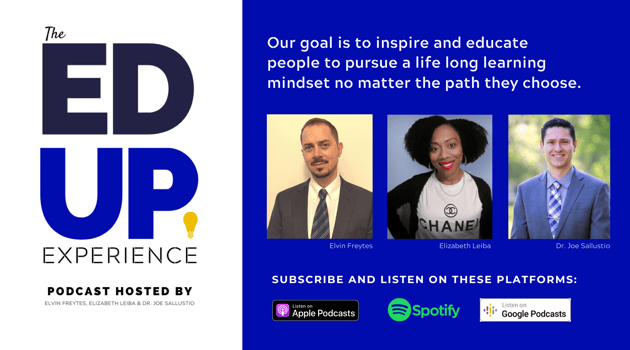Published on
Delivering the Best Experience Through Disruption

The pandemic’s disruption has highlighted the weak spots within higher ed, and institutions are beginning to strengthen them within their infrastructure, but it’s important to focus on the student and what they need. They too are lost within the chaos and are looking for more guidance than usual. This is higher ed’s chance to connect with students and build a better lifelong learning relationship that keeps the learner coming back throughout their career journey. In this interview, Joe Sallustio and Elizabeth Leiba from EdUp Experience talk with Mary Papazian about San Jose State’s Adapt model, current issues they’re addressing both on and off campus, and current trends within the higher ed space.
EdUp Experience: How are you managing all of the concerns, feelings and ideas of your staff and students?
Mary Papazian (MP): You have to have a great team. In moments like this it’s so important. I have an amazing leadership team, and in working together there’s a lot of support. We’ve been able to create a sense of a shared commitment and trust that we have everyone’s best interests at the forefront. It’s about listening, being thoughtful and, frankly, expressing empathy. Recognizing that people are going through so much—whether we know it or not. So, we just have to be empathetic and patient. On top of that, we have to be clear about what we’re trying to do and what we don’t know.
EdUp Experience: With all of this disruption, have you invested more into the mental health component of it all?
MP: We’ve had to be very intentional about supporting students because you’re right; there’s so much disruption. When you think about the impact on our students, particularly those we serve at San Jose State, there area lot of first-generation students who come from families impacted by the economic pressures and job losses. So, we have to be present. We’ve expanded our tele-mental health. We’ve kept our health and wellness center open, both physically and virtually, and our student affairs team have been in constant contact with our students.
The challenge is knowing whether you’re reaching every single student. We have 35,000 students, all with their own challenges. We’ve been living a world with these challenges for a while. We’ve had the services there, but we want to let students know that they’re available if needed. One thing we’ve invested in significantly is making sure students have the ability to take classes remotely—and for us to work remotely—but still have a good experience. It’s a challenge, but we’re working hard to do it right.
EdUp Experience: What is San Jose State’s Adapt model and what it means to the university and its students?
MP: We went with the Adapt model in part because we realized pretty early on that this was not going to be a progression to good. We had to adapt to whatever the changing circumstances, so we were trying to align ourselves with the guidelines from our country, our state and public health officials. The health and safety of our students, faculty, staff, and community has to be the guiding light for us.
We have to really be intentional and make sure folks have clarity, so they can really anticipate the next steps. For our students, it’s about what their learning and campus experiences will look like. We have a very active and robust research program with our faculty and students, so what will the future look like for our researchers?
EdUp Experience: Can you speak about social justice on campus?
MP: We’re living in this remarkable time when we have 1918 with the Spanish Flu pandemic; we’ve got the economic depression of the ’30s; and then we’ve got 1968, the civil rights movement and all that that entails all wrapped up into one. But they do intersect, and this is really important. And this isn’t something that’s new to our thinking. We have a strong social justice history. We have also historically been a little uncomfortable with what that means. So, in really recognizing that in this diverse community in which we live, we have an obligation to face these issues honestly, directly and in a way that isn’t just apologizing but is in fact bringing about transformative change.
We can’t control the community at large, but we can certainly control and impact our campus. A rising tide lifts all boats, and when we address this really powerful injustice in our society that’s been with America from its founding, we will also create a better society for our Latinx students, for our indigenous population, and for our LGBTQ population.
EdUp Experience: Can you talk about your initiative to address housing insecurity?
MP: San Jose is in the heart of Silicon Valley, which is the most expensive housing market in the country. So, we know what the pressures are and that there are huge disparities in our society because of it. There’s a huge impact on our students but also on our faculty and staff, and we had to figure out a way to address it. Our Student Housing Alliance was great at coming together and realizing that we need to do better, that we needed to find a way to prevent students from sleeping in their cars and or being homeless. So, we worked with them to create a comprehensive solution that really addresses all of it by finding real solutions.
On the faculty side, we’re part of a public university system. And as a public university, our ability to pay salaries is limited. So, we have this salary structure that’s been agreed upon, but the same dollars don’t go as far in San Jose as they might in other parts of the state. To attract and retain staff, we need to take cost out for them, which means trying to think more creatively about housing. A feature in this comprehensive strategy is working with our local state senator and other state officials to develop a piece of property near campus to create under-market housing. We’re hoping it’s about 75% of market value for faculty, staff and graduate students. It’s currently in the design and planning stages with a projected 2025 occupancy.
EdUp Experience: What current trends are you seeing in terms of enrollment and online education?
MP: It’s going to vary across the country and among type of institution. Cal State University’s tuition fees that are among the lowest in the country, and we educate a striving diverse student population. We are escalators of social mobility. Our enrollment staff have worked phenomenally hard and had to rethink everything they’ve done. Usually, we do an Admitted Spartan Day during which 10,000 people are on campus. Everything was transitioned to a virtual model with interactive videos. We did the same for our orientation. There’s been a real commitment to meet students where they are, and that’s what you have to do now and going forward. We can’t emerge from this looking like we were when we went into it.
Our freshman numbers have decreased slightly from last year, but they’re close to our target, and our transfer numbers actually increased. We have this robust community college system in California, and we’re seeing real success with students on the transfer side. And we’re seeing increases in average unit loads in our continuing ed students.
Where we’re hitting the drop is with international students. We’re ranked number ten with the most international students in the State of California. Continuing international students are okay because many of them were already in this country. But with new rules in place, there’s still a lot of anxiety about it. We live in the heart of the global innovation economy, and our local students benefit from having international students. We’re working really hard to keep those numbers where they are, but we don’t know what will happen.
EdUp Experience: How does your background in the liberal arts inform the way you make connections?
MP: When I was first appointed president, people questioned how an English professor was appointed to head the Silicon Valley university, which is known as a talent pipeline for Silicon Valley. We’re not a technical school, but I asked them when the last great innovation age was. It was the Renaissance.
Think about all the ways in which we learned about learning. We learned about William Harvey and the discovery of blood circulation, Sir Francis Bacon and the scientific method, and Galileo and the universe. There were so many things that changed. And it was the integration of all different perspectives that created real innovation. What we’re finding now in technology is that more humanities and social science majors are hired in Silicon Valley than STEM majors. A lot of company leaders actually come from a humanities background themselves. It’s the ability to see the bigger picture, to make connections, to communicate and work with people.
So, institutions looking to cut their liberal arts and humanities programs are making a mistake. Certainly, in this fourth digital revolution, the economy needs humanists more than ever to work in partnership with our scientists, engineers and data folks. If I’m creating artificial intelligence, I want somebody who’s going to think about what impact it has on our community. It’s the application of these things from a human and community perspective. If you don’t have the humanities and the social sciences in that conversation, it’s not happening. That’s why it’s really important, and this integration of learning is ultimately what we really need.
EdUp Experience: Is there anything else you’d like to add and what is the future of higher education?
MP: Institutions like San Jose State are really well positioned to think about the future of learning and higher education. We’re the oldest public university in the west, and we’re also the only public university in Silicon Valley, the heart of innovation. And we really think in those terms about what the future will look like because we see it in these companies surrounding us. At San Jose State, we think about engaging these diverse students, these first-gen students, these aspiring students in really thinking about the big questions of our day. How are we going to engage thinking about these problems and their solutions? Putting problem-solving at the front of is critical in thinking about learning and meeting students where they are.
Many of our learners are coming from underserved communities where there are major digital disparities. So, the more experience we can give these students in the digital environment, the better suited they’ll be for future work. They’ll be able to go into the job market and have a competitive edge. This will be really important for closing the gaps in tech—which impact all of us. We see this as a role we can play, but we also have to understand that our students come to us with different backgrounds and intentions, and we need to meet them where they are. We can get there, but this is a time to be very innovative and creative about the way we develop curriculums.
This interview was edited for length and clarity.
Listen to the full interview here.




